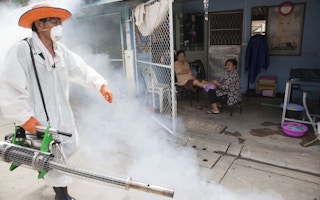Human-caused climate change has a complex effect on insect-borne diseases. Many may be spreading more, but effective strategies exist to manage this risk. These strategies are available to all countries, rich and poor.
Illnesses carried and transmitted by mosquitoes, such as malaria, dengue fever and encephalitis (the latter also spread by ticks), are likely to spread more widely in a warming world. Other insect-borne diseases such as Lyme disease (spread by ticks), leishmaniasis (spread by sandflies) and West Nile fever (spread by mosquitoes) should be closely watched so the impact of climate change on them can be assessed — especially in tandem with the effects of urbanisation and expanding human encroachment into ecosystems.
As the world’s temperatures increase, summers are lasting longer and the life cycles of many insects — and the microbes or parasites they carry – are speeding up. Many insects and parasites mature earlier and breed more often. They can also go through more life cycles in a year, and the insects might bite more frequently.
Yet the relationships between life-cycle timings and environmental temperatures are not linear. For one dengue-carrying mosquito, both its survival rate and its ability to complete a blood meal decline as temperatures rise above 28 degrees Celsius.
Where rising temperatures support insect survival, their number within a geographic area increases, providing more opportunities for insects and humans to meet. The insects also extend their territories, moving up slopes to higher elevations as well as north and south to higher latitudes. People living in these places are not used to these insects, pathogens or diseases, so they might lack immunity and be less aware of symptoms and possible countermeasures.
Other animals contribute to the transmission of insect-borne diseases. For example, birds host the West Nile virus, helping mosquitoes to spread it to humans. And so the influence of climate change on the birds and their ecosystems is part of the overall impact of climate change on the disease.
Altered ranges of insect-transmitted diseases are not just about changing climates but also about possible countermeasures. Some worry that malaria may appear in Europe and North America due to climate change, but the disease has already made its way there in recent times for other reasons.
Isolated cases are frequently identified, from mosquitoes hopping off aircraft in Frankfurt, Germany, to people returning from malarial areas and then becoming sick in Ontario, Canada. The disease has a long history in places such as England — until it started declining noticeably in the 19th century — and Colorado, United States, where mosquitoes with parasite-carrying potential remain.
Measures to eliminate malaria and keep it from returning include draining wetlands, using netting on porches and windows, and using insecticides. But insecticides can lead to other problems, notably cancer.
The effect of one mosquito species that spreads chikungunya, dengue fever, mayaro fever, yellow fever and Zika can be limited by effective management. In less developed economies, improved hygiene, sanitation and healthcare reduced vulnerability to these diseases by 34 per cent from 2000 to 2017. Simultaneously, more developed economies reduced their populations’ vulnerability to the diseases by more than 61 per cent. This is despite more suitable environmental conditions for transmitting these diseases since the 1950s.
For instance, the number of months suited to malaria transmission increased by 15 to 39 per cent in the highland areas of less-to-medium developed countries. China’s Hainan Island is highly prone to malaria, and more so as the climate warms, yet it eliminated the disease through interventions including medications and insecticide-permeated bed nets.
The lesson is that diseases transmitted by insects can be controlled, even as social and environmental conditions become more amenable to their spread. And not all of climate change’s impacts support the spread of insects and the diseases they carry.
In many places, rainfall is becoming more intense due to climate change. This means more areas might get wet, promoting insect breeding, but it also means eggs and larvae can be washed away, breaking the insects’ life cycles.
Drought impacts are equally complex. Mosquitoes appear to adapt to drier conditions by finding all available water sources, while ticks tend not to — although there must be survival limits when most moisture disappears.
Rising sea levels are adding salt to coastal waters. Some mosquitoes carrying malaria and Ross River virus thrive in brackish waters, while those carrying dengue and yellow fever can manage, depending on the salt concentration. Ticks in the US showed much poorer survival in brackish water and saltwater than in freshwater.
Irrespective of the insects’ ability to survive, measures to control them can be put in place. Proper drainage of irrigated land significantly reduces the risk of disease transmission, including when fields become saltier. Sealing rainwater collection and storage containers prevents insects from using them as breeding sites – although financial and technical support is required for this practice to become widespread.
Ultimately, health measures available to everyone are the most effective ways to limit the spread of insect-borne disease. Prevention-focused social and medical changes include reducing human–insect contact, developing vaccines, and improving health systems for disease detection and treatment.
In these ways, the links between insect-borne diseases and human-caused climate change can be severed.
Ilan Kelman is Professor of Disasters and Health at University College London, England, and a Professor II at the University of Agder, Kristiansand, Norway. His overall research interest is linking disasters and health, including the integration of climate change into disaster research and health research.
The author declares no conflict of interest.
Originally published under Creative Commons by 360info™.









